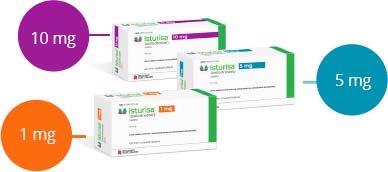Are you a Healthcare Professional?
The information contained in this section of the website is intended for US healthcare professionals only. Click CONFIRM to confirm that you are a healthcare professional.
"(Required)" indicates required fields
You are about to leave the ISTURISA.com website and enter a website operated by an independent third party. The links to third-party websites contained on ISTURISA.com are provided solely for your convenience. Recordati Rare Diseases does not control the opinions, claims or comments contained on any third-party website linked to ISTURISA.com, and your activities at those websites will be governed by the policies and practices of those third parties.

ISTURISA reduces the amount of cortisol made in your adrenal glands. With ISTURISA, less cortisol is made, so less cortisol is released into your bloodstream.
Like all medicines, ISTURISA can cause side effects.
Your healthcare provider will work with you to help manage these by temporarily stopping treatment, adjusting your dose, or treating them with other medicines.
There are other serious side effects that can occur with ISTURISA. For more information, ask your healthcare provider.
ISTURISA can cause serious side effects, including
Tell your healthcare provider right away if you experience more than one of the following symptoms, as these may be symptoms of very low cortisol level, known as adrenal insufficiency:
If you experience symptoms of hypocortisolism while taking ISTURISA, your healthcare provider may change your dose or ask you to stop taking it.
Your healthcare provider can modify your dose of ISTURISA based on your individual response. If you experience side effects, your healthcare provider can adjust your dose.
You should take ISTURISA exactly as your healthcare provider recommends. And, if you begin to experience any side effects, be sure to talk to your healthcare provider right away.
ISTURISA offers flexible dosing options and comes in 3 different strengths: 1 mg, 5 mg, and 10 mg. This allows your healthcare provider the flexibility to adjust the dose you need to normalize your cortisol levels while trying to balance the risk of side effects.

Talk to your healthcare provider about how you’re feeling, your symptoms, and your treatment goals so he or she can help find the amount of ISTURISA that’s right for you.
If you experience side effects, please contact your healthcare provider right away.

After starting ISTURISA, my doctor and I worked together to find the dose that was right for me.
ISTURISA (osilodrostat) is used to treat adults with Cushing’s disease who cannot have pituitary surgery, or who have had pituitary surgery, but the surgery did not cure their Cushing’s disease.
To report SUSPECTED SIDE EFFECTS, contact Recordati Rare Diseases Inc. at 1-888-575-8344, or FDA at 1-800-FDA-1088 or www.fda.gov/medwatch.
Before taking ISTURISA, tell your doctor about all of your medical conditions, including if you:
Tell your healthcare provider about all the medicines you take, including prescription medicines, over-the-counter medicines, vitamins, and herbal supplements. Especially tell your healthcare provider if you take medicines used to treat certain heart problems. Ask your healthcare provider if you are not sure whether your medicine is used to treat heart problems.
Please see the Full Prescribing Information, including the Medication Guide, for ISTURISA and talk with your healthcare provider.
The information contained in this section of the website is intended for US healthcare professionals only. Click CONFIRM to confirm that you are a healthcare professional.
You are now leaving the ISTURISA® (osilodrostat) website. This link will take you to a site maintained by a third party who is solely responsible for its content.